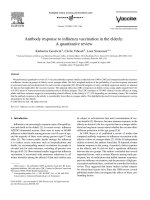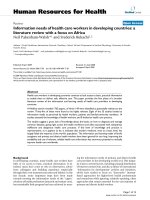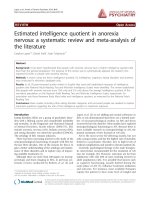Some subgroup embeddings in finite groups: A mini review
Bạn đang xem bản rút gọn của tài liệu. Xem và tải ngay bản đầy đủ của tài liệu tại đây (409.09 KB, 4 trang )
Journal of Advanced Research (2015) 6, 359–362
Cairo University
Journal of Advanced Research
MINI REVIEW
Some subgroup embeddings in finite groups: A mini
review
A. Ballester-Bolinches
M.F. Ragland d
a,*
, J.C. Beidleman b, R. Esteban-Romero
c,1
,
Departament d’A`lgebra, Universitat de Vale`ncia, Dr. Moliner, 50, 46100 Burjassot, Vale`ncia, Spain
Department of Mathematics, University of Kentucky, Lexington, KY 40506-0027, USA
c
Institut Universitari de Matema`tica Pura i Aplicada, Universitat Polite`cnica de Vale`ncia, Camı´ de Vera, s/n, 46022 Vale`ncia, Spain
d
Department of Mathematics, Auburn University at Montgomery, P.O. Box 244023, Montgomery, AL 36124-4023, USA
a
b
A R T I C L E
I N F O
Article history:
Received 3 April 2014
Received in revised form 15 April 2014
Accepted 18 April 2014
Available online 26 April 2014
A B S T R A C T
In this survey paper several subgroup embedding properties related to some types of permutability are introduced and studied.
ª 2014 Production and hosting by Elsevier B.V. on behalf of Cairo University.
Keywords:
Finite group
Permutability
S-permutability
Semipermutability
Primitive subgroup
Quasipermutable subgroup
Introduction
All groups in the paper are finite.
The purpose of this survey paper is to show how the embedding of certain types of subgroups of a finite group G can
* Corresponding author. Tel.: +34 639560201; fax: +34 963543918.
E-mail addresses: (A. Ballester-Bolinches),
(J.C.
Beidleman),
,
(R. Esteban-Romero),
(M.F. Ragland).
1
Current address: Departament d’A`lgebra, Universitat de Vale`ncia,
Dr. Moliner, 50, 46100 Burjassot, Vale`ncia, Spain.
Peer review under responsibility of Cairo University.
determine the structure of G. The types of subgroup
embedding properties we consider include: S-permutability,
S-semipermutability, semipermutability, primitivity, and
quasipermutability.
A subgroup H of a group G is said to permute with a
subgroup K of G if HK is a subgroup of G. H is said to be
permutable in G if H permutes with all subgroups of G. A less
restrictive subgroup embedding property is the S-permutability
introduced by Kegel and defined in the following way:
Definition 1. A subgroup H of G is said to be S-permutable in
G if H permutes with every Sylow p-subgroup of G for every
prime p.
In recent years there has been widespread interest in the
transitivity of normality, permutability and S-permutability.
Production and hosting by Elsevier
2090-1232 ª 2014 Production and hosting by Elsevier B.V. on behalf of Cairo University.
/>
360
Definition 2.
1. A group G is a T-group if normality is a transitive relation
in G, that is, if every subnormal subgroup of G is normal
in G.
2. A group G is a PT-group if permutability is a transitive
relation in G, that is, if H is permutable in K and K is
permutable in G, then H is permutable in G.
3. A group G is a PST-group if S-permutability is a transitive
relation in G, that is, if H is S-permutable in K and K is
S-permutable in G, then H is S-permutable in G.
If H is S-permutable in G, it is known that H must be
subnormal in G ([1, Theorem 1.2.14(3)]). Therefore, a group
G is a PST-group (respectively a PT-group) if and only if every
subnormal subgroup is S-permutable (respectively permutable)
in G.
Note that T implies PT and PT implies PST. On the other
hand, PT does not imply T (non-Dedekind modular p-groups)
and PST does not imply PT (non-modular p-groups). The
reader is referred to [1, Chapter 2] for basic results about these
classes of groups. Other characterisations based on subgroup
embedding properties can be found in [2].
Agrawal ([1, 2.1.8]) characterised soluble PST-groups. He
proved that a soluble group G is a PST-group if and only if
the nilpotent residual in G is an abelian Hall subgroup of G
on which G acts by conjugation as power automorphisms. In
particular, the class of soluble PST-groups is subgroup-closed.
Let G be a soluble PST-group with nilpotent residual L.
Then G is a PT-group (respectively T-group) if and only if
G=L is a modular (respectively Dedekind) group ([1, 2.1.11]).
Definition 3 [3]. A subgroup H of a group G is said to be
semipermutable (respectively, S-semipermutable) provided that
it permutes with every subgroup (respectively, Sylow
subgroup) K of G such that gcdðjHj; jKjÞ ¼ 1.
A. Ballester-Bolinches et al.
Research papers on BT-groups include [4–7].
We next present an example of a soluble PST-group which
is not a BT-group.
Example 6. Let L be a cyclic group of order 7 and
A ¼ C3 Â C2 be the automorphism group of L. Here C3
(respectively, C2 ) is the cyclic group of order 3 (respectively, 2).
Let G ¼ ½LA be the semidirect product of L by A. Let L ¼ hxi,
C3 ¼ hyi and C2 ¼ hzi and note that ½hyix ; hzi–1. Now G is a
PST-group by Agrawal’s theorem, but G is not a BT-group by
Theorem 5.
A subclass of the class of soluble BT-groups is the class of
soluble SST-groups, which has been introduced in [8].
Definition 7 (see [9]). A subgroup H of a group G is said to be
SS-permutable (or SS-quasinormal) in G if H has a supplement
K in G such that H permutes with every Sylow subgroup of K.
Definition 8 (see [8]). We say that a group G is an SST-group if
SS-permutability is a transitive relation.
SS-permutability can be used to obtain a characterisation
of soluble PST-groups.
Theorem 9 [8]. Let G be a group. Then the following statements
are equivalent:
1. G is soluble and every subnormal subgroup of G is SS-permutable in G.
2. G is a soluble PST-group.
Theorem 10 [8]. A soluble SST-group G is a BT-group.
The following example shows that a soluble BT-group is
not necessarily an SST-group.
L. Wang, Y. Li, and Y. Wang proved the following
theorem which showed that soluble BT-groups are a subclass
of PST-groups:
Example 11 [8]. Let G ¼ hx; y j x5 ¼ y4 ¼ 1; xy ¼ x2 i. The
nilpotent residual of G is the Sylow 5-subgroup hxi. By
Theorem 5, G is a soluble BT-group. Let H ¼ hyi and
M ¼ hy2 i. Suppose that M is SS-permutable in G. Then G is
the unique supplement of M in G. It follows that M is Spermutable in G, and thus M 6 O2 ðGÞ. This implies that either
x
O2 ðGÞ ¼ H or O2 ðGÞ ¼ M. Since yx ¼ yxÀ1 and ðy2 Þ ¼ y2 x2 ,
neither H nor M are normal subgroups of G. This contradiction shows that M is not SS-permutable in G. Since M is SSpermutable in hx; y2 i and this subgroup is SS-permutable in G,
we obtain that the soluble group G cannot be an SST-group.
Theorem 5 [4]. Let G be a group with nilpotent residual L. The
following statements are equivalent:
A less restrictive class of groups is the class of T0 -groups
which has been studied in [5,7,10–12].
1. G is a soluble BT-group.
2. Every subgroup of G of prime power order is Ssemipermutable.
3. Every subgroup of G of prime power order is semipermutable.
4. Every subgroup of G is semipermutable.
5. G is a soluble PST-group and if p and q are distinct primes
not dividing the order of L with Gp a Sylow p-subgroup of
G and Gq a Sylow q-subgroup of G, then ½Gp ; Gq ¼ 1.
Definition 12. A group G is called a T0 -group if the Frattini
factor group G=UðGÞ is a T-group.
An S-semipermutable subgroup of a group need not be subnormal. For example, a Sylow 2-subgroup of the nonabelian
group of order 6 is semipermutable and S-semipermutable,
but not subnormal.
Definition 4 (see [4]). A group G is called a BT-group if
semipermutability is a transitive relation in G.
Theorem 13 [11]. Let L be the nilpotent residual of the soluble
T0 -group. Then:
1. G is supersoluble;
2. L is a nilpotent Hall subgroup of G.
Some subgroup embeddings in finite groups: A mini review
Theorem 14 [10]. Let G be a soluble T0 -group. If all the
subgroups of G are T0 -groups, then G is a PST-group.
A group G is called an MS-group if the maximal subgroups
of all the Sylow subgroups of G are S-semipermutable.
Theorem 15 [13]. If G is an MS-group, then G is supersoluble.
Theorem 16 [7]. Let L be the nilpotent residual of an MS-group
G. Then:
1. L is a nilpotent Hall subgroup of G;
2. G is a soluble T0 -group.
We now provide three examples which illustrate several
properties and differences of some of the classes presented in
this paper. These examples are from [6,7].
Example 17. Let C ¼ hxi be a cyclic group of order 7 and let
A ¼ hyi  hzi be a cyclic group of order 6 with y an element of
order 3 and z an element of order 2. Then A ¼ AutðCÞ. Let
G ¼ ½CA be the semidirect product of C by A. Then ½hyiz ; z–1
and G is not a soluble BT-group. However, G is an MS-group.
361
Theorem 20 [6]. Let G be a group with nilpotent residual L.
Then G is an MS-group if and only if G satisfies the following:
1. G is a T0 -group.
2. L is a nilpotent Hall subgroup of G.
3. If p 2 p and P 2 Sylp ðGÞ, then a maximal subgroup of P is
normal in G.
4. Let p and q be distinct primes with p 2 hN and q 2 h. If
P 2 Sylp ðGÞ and Q 2 Sylq ðGÞ, then ½P ; Q ¼ 1.
5. Let p and q be distinct primes with p 2 hC and q 2 h. If
P 2 Sylp ðGÞ and Q 2 Sylq ðGÞ and M is the maximal subgroup of P, then QM ¼ MQ is a nilpotent subgroup of G.
Theorem 21 [6]. Let G be a soluble PST-group. Then G is an
MS-group if and only if G satisfies 4 and 5 of Theorem 20.
Theorem 22 [6]. Let G be a soluble PST-group which is also an
MS-group. If hC is the empty set, then G is a BT-group.
Definition 23 [14]. A subgroup H of a group G is called
primitive if it is a proper subgroup in the intersection of all
subgroups containing H as a proper subgroup.
Example 18 shows that the classes of MS- and T0 -groups
are not subgroup closed.
All maximal subgroups of G are primitive. Some basic
properties of primitive subgroups include:
Example 18. Let H ¼ hx; y j x3 ¼ y3 ¼ ½x; y3 ¼ ½x; ½x; y ¼
½y; ½x; y ¼ 1i be an extraspecial group of order 27 and
exponent 3. Then H has an automorphism a of order 2 given
by xa ¼ xÀ1 , ya ¼ yÀ1 and ½x; ya ¼ ½x; y. Put G ¼ ½Hhai, the
semidirect product of H by hai. Let z ¼ hx; yi. Then
UðGÞ ¼ UðHÞ ¼ hzi ¼ ZðGÞ ¼ ZðHÞ. Note that G=UðGÞ is a
T-group so that G is a T0 -group. The maximal subgroups of H
are normal in G and it follows that G is an MS-group. Let
K ¼ hx; z; ai. Then hxzi is a maximal subgroup of hx; zi, the
Sylow 3-subgroup of K. However, hxzi does not permute with
hai and hence hxzi is not an S-semipermutable subgroup of K.
Therefore, K is not an MS-subgroup of G. Also note that
UðKÞ ¼ 1 and so K is not a T-subgroup of G and K is not a T0 subgroup of G. Hence the class of soluble T0 -groups is not
closed under taking subgroups. Note that G is not a soluble
PST-group.
Proposition 24.
Example 19 presents an example of a soluble PST-group
which is not an MS-group.
Example 19. Let C ¼ hxi be a cyclic group of order 192 ,
D ¼ hyi a cyclic group of order 32 , and E ¼ hzi is a cyclic
group of order 2 such that D Â E 6 AutðCÞ. Then
G ¼ ½CðD Â EÞ is a soluble PST-group and G is not an
MS-group since ½hy2 ix ; z–1.
The following notation is needed in the presentation of the
next theorem which characterises MS-groups. Let G be a
group whose nilpotent residual L is a Hall subgroup of G.
Let p ¼ pðLÞ and let h ¼ p0 , the complement of p in the set
of all prime numbers. Let hN denote the set of all primes p in
h such that if P is a Sylow p-subgroup of G, then P has at least
two maximal subgroups. Further, let hC denote the set of all
primes q in h such that if Q is a Sylow q-subgroup of G, then
Q has only one maximal subgroup or, equivalently, Q is cyclic.
1. Every proper subgroup of G is the intersection of a set of
primitive subgroups of G.
2. If X is a primitive subgroup of a subgroup T of G, then there
exists a primitive subgroup Y of G such that X ¼ Y \ T .
Johnson [14] proved that a group G is supersoluble if every
primitive subgroup of G has prime power index in G.
The next results on primitive subgroups of a group G
indicate how such subgroups give information about the
structure of G.
Theorem 25 [15]. Let G be a group. The following statements
are equivalent:
1. Every primitive subgroup of G containing UðGÞ has prime
power index.
2. G=UðGÞ is a soluble PST-group.
Theorem 26 [16]. Let G be a group. The following statements
are equivalent:
1. Every primitive subgroup of G has prime power index.
2. G ¼ ½LM is a supersoluble group, where L and M are
nilpotent Hall subgroups of G; L is the nilpotent residual of
G and G ¼ LNG ðL \ X Þ for every primitive subgroup X of
G. In particular, every maximal subgroup of L is normal in G.
Let X denote the class of groups G such that the primitive
subgroups of G have prime power index. By Proposition 24
(1), it is clear that X consists of those groups whose subgroups
are intersections of subgroups of prime power indices.
362
The next example shows that the class X is not subgroup
closed.
Example 27. Let P ¼ hx; yjx5 ¼ y5 ¼ ½x; y5 ¼ 1i be an
extraspecial group of order 125 and exponent 5. Let
z ¼ ½x; y and note that ZðPÞ ¼ UðPÞ ¼ hzi. Then P has an
automorphism a of order four given by xa ¼ x2 ; ya ¼ y2 , and
za ¼ z4 ¼ zÀ1 . Put G ¼ ½Phai and note that ZðGÞ ¼ 1; UðGÞ ¼
hzi, and G=UðGÞ is a T-group. Thus G is a soluble T0 -group.
Let H ¼ hy; z; ai and notice that UðHÞ ¼ 1. Then H is not a
T-group since the nilpotent residual L of H is hy; zi and a does
not act on L as a power automorphism. Thus H is not a
T0 -group, and hence not a soluble PST-group. By Theorem 25,
G is an X-group and H is not an X-group.
Theorem 28 [17]. Let G be a group. The following statements
are equivalent:
1. G is a soluble PST-group.
2. Every subgroup of G is an X-group.
We bring the paper to a close with the quasipermutable
embedding which is defined in the following way.
Definition 29. A subgroup H is called quasipermutable in G
provided there is a subgroup B of G such that G ¼ NG ðHÞB
and H permutes with B and with every subgroup (respectively,
with every Sylow subgroup) A of B such that gcdðjHj; jAjÞ ¼ 1.
Theorem 30 contains new characterisations of soluble PSTgroups with certain Hall subgroups.
Theorem 30 [18]. Let D ¼ GN be the nilpotent residual of the
group G and let p ¼ pðDÞ. Then the following statements are
equivalent:
1. D is a Hall subgroup of G and every Hall subgroup of G is
quasipermutable in G.
2. G is a soluble PST-group.
3. Every subgroup of G is quasipermutable in G.
4. Every p-subgroup of G and some minimal supplement of D in
G are quasipermutable in G.
Conflict of interest
The authors have declared no conflict of interest.
Compliance with Ethics Requirements
This article does not contain any studies with human or animal
subjects.
A. Ballester-Bolinches et al.
Acknowledgements
The work of the first and the third authors has been supported
by the Grant MTM2010-19938-C03-03 from the Ministerio de
Economı´a y Competitividad, Spain. The first author has also
been supported by the Grant 11271085 from the National Natural Science Foundation of China.
References
[1] Ballester-Bolinches A, Esteban-Romero R, Asaad M. Products
of finite groups. Vol. 53 of de Gruyter Expositions in
Mathematics. Berlin: Walter de Gruyter; 2010. http://
dx.doi.org/10.1515/9783110220612.
[2] Beidleman JC. Weakly normal subgroups and classes of finite
groups. Note Mat 2012;32(2):115–21.
[3] Chen ZM. On a theorem of Srinivasan. Southwest Normal Univ
Nat Sci 1987;12(1):1–4.
[4] Wang L, Li Y, Wang Y. Finite groups in which (S-)
semipermutability is a transitive relation. Int J Algebra
2008;2(1–4):143–52, Corrigendum in Int J Algebra 2012;6(13–
16):727–8.
[5] Al-Sharo KA, Beidleman JC, Heineken H, Ragland MF. Some
characterizations of finite groups in which semipermutability is a
transitive
relation.
Forum
Math
2010;22(5):855–62,
Corrigendum in Forum Math 2012;24(7):1333–34.
[6] Ballester-Bolinches A, Beidleman JC, Esteban-Romero R,
Ragland MF. On a class of supersoluble groups. Bull Austral
Math Soc 2014;90:220–26.
[7] Beidleman JC, Ragland MF. Groups with maximal subgroups
of Sylow subgroups satisfying certain permutability conditions.
Southeast Asian Bull Math (in press).
[8] Chen XY, Guo WB. Finite groups in which SS-permutability is
a transitive relation. Acta Math Hungar 2014;143(2):446–79.
[9] Li SR, Shen ZC, Liu JJ, Liu XC. The influence of SSquasinormality of some subgroups on the structure of finite
groups. J Algebra 2008;319:4275–87.
[10] Ballester-Bolinches A, Esteban-Romero R, Pedraza-Aguilera
MC. On a class of p-soluble groups. Algebra Colloq
2005;12(2):263–7.
[11] Ragland MF. Generalizations of groups in which normality is
transitive. Commun Algebra 2007;35(10):3242–52.
[12] van der Waall RW, Fransman A. On products of groups for
which normality is a transitive relation on their Frattini factor
groups. Quaestiones Math 1996;19:59–82.
[13] Ren YC. Notes on p-quasi-normal subgroups in finite groups.
Proc Am Math Soc 1993;117:631–6.
[14] Johnson DL. A note on supersoluble groups. Can J Math
1971;23:562–4.
[15] He X, Qiao S, Wang Y. A note on primitive subgroups of finite
groups. Commun Korean Math Soc 2013;28(1):55–62.
[16] Guo W, Shum KP, Skiba AN. On primitive subgroups of finite
groups. Indian J Pure Appl Math 2006;37(6):369–76.
[17] [17] Ballester-Bolinches A, Beidleman JC, Esteban-Romero R.
Primitive subgroups and PST-groups. Bull Austral Math Soc
2014;89(3):373–8.
[18] Yi X, Skiba AN. Some new characterizations of PST-groups. J
Algebra 2014;399:39–54.









